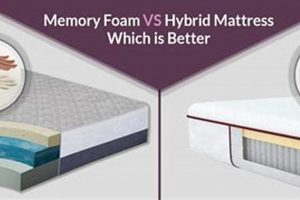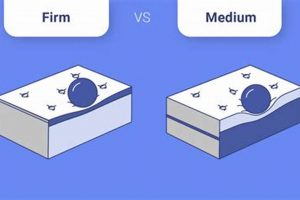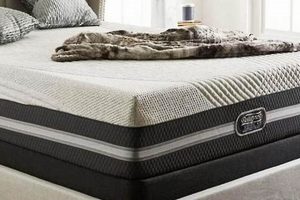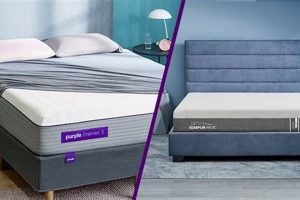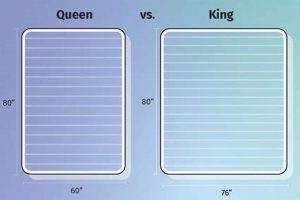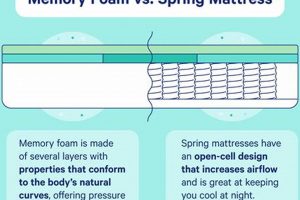An analysis of competing mattress brands, specifically focusing on Puffy and Purple, reveals distinct design philosophies and material choices that cater to differing consumer preferences. Puffy emphasizes memory foam construction for conforming support and pressure relief, while Purple utilizes a unique polymer grid system designed to offer a balance of support and airflow. Understanding these core differences is crucial for making an informed purchasing decision.
The selection of a mattress significantly impacts sleep quality and overall well-being. Factors such as spinal alignment, temperature regulation, and motion isolation are all influenced by the mattress’s construction. The features of Puffy, known for its potential to alleviate pressure points, and Purple, recognized for its breathability and responsiveness, address these factors in unique ways, presenting potential advantages depending on individual needs.
The subsequent sections will delve into a detailed comparison of these two mattress options, examining their construction, performance characteristics, and overall value propositions. This will provide a comprehensive overview designed to help consumers determine which mattress best aligns with their specific sleep requirements and budget considerations.
Guidance for Mattress Selection
The following recommendations provide a structured approach for evaluating Puffy and Purple mattresses, ensuring a selection aligned with individual sleep needs and preferences. Careful consideration of these factors will enhance the likelihood of a satisfactory purchase.
Tip 1: Assess Sleep Position: Side sleepers generally benefit from the enhanced pressure relief offered by memory foam, a core feature of Puffy mattresses. Back and stomach sleepers may find the firmer, more responsive support of the Purple grid system advantageous for maintaining spinal alignment.
Tip 2: Consider Body Weight: Individuals with higher body weights often require mattresses with robust support systems to prevent sagging and ensure proper spinal alignment. Investigate the specific coil systems and support layers within each mattress to determine suitability.
Tip 3: Evaluate Temperature Regulation: If overheating during sleep is a concern, prioritize mattresses with enhanced airflow. The Purple grid system is specifically designed to promote ventilation, potentially offering a cooler sleep experience compared to traditional memory foam mattresses.
Tip 4: Research Motion Isolation: For couples, motion isolation is a critical factor in minimizing sleep disturbance. Memory foam mattresses, like those offered by Puffy, typically excel at absorbing movement, preventing it from transferring across the bed.
Tip 5: Examine Trial Periods and Warranties: Both Puffy and Purple offer trial periods allowing for in-home testing. Carefully review the terms of these trials, as well as the mattress warranties, to understand the recourse available in case of dissatisfaction or product defects.
Tip 6: Analyze Material Composition: Investigate the specific materials used in each mattress, paying attention to certifications such as CertiPUR-US, which indicate that the foam has been tested for harmful chemicals and emissions. This ensures a healthier sleep environment.
Tip 7: Review Verified Customer Feedback: Supplement independent research with customer reviews from reputable sources. Focus on feedback that addresses specific concerns relevant to individual sleep needs, such as pressure relief, support, or temperature regulation.
Prioritizing these considerations ensures a more informed decision, leading to the selection of a mattress that effectively addresses individual sleep needs and contributes to improved rest and overall well-being.
The next section will conclude the analysis by summarizing the key distinctions and offering final recommendations based on varying sleep profiles.
1. Material Composition
The material composition of both Puffy and Purple mattresses directly dictates their performance characteristics, influencing factors such as comfort, support, durability, and temperature regulation. A detailed understanding of these materials is essential for consumers seeking to make an informed choice.
- Puffy Mattress Core Materials
Puffy mattresses primarily utilize various densities of memory foam in their construction. These foams, often infused with cooling gels, are designed to conform to the sleeper’s body, providing pressure relief and minimizing motion transfer. The specific layering and density of these foams contribute to the overall feel and support of the mattress. For example, higher density foams are generally used in the support core to provide structural stability and prevent sagging, while softer foams are used in the comfort layers for cushioning. The CertiPUR-US certification of Puffy’s foams indicates compliance with standards for content, emissions, and durability.
- Purple Mattress Polymer Grid Technology
Purple mattresses are distinguished by their use of a proprietary hyper-elastic polymer grid. This grid is designed to provide a unique combination of pressure relief and support. The grid collapses under pressure, cradling the body and preventing pressure points, while simultaneously providing support by distributing weight evenly. The underlying support layers typically consist of high-density polyurethane foam, providing a stable base for the grid. The open grid structure also promotes airflow, enhancing temperature regulation. The composition of this grid significantly differentiates Purple from traditional memory foam mattresses.
- Cover Materials and Their Impact
The cover materials used in both Puffy and Purple mattresses contribute to overall comfort and breathability. Puffy often uses a stretch-knit cover designed to enhance airflow and conform to the body. Purple employs a similar stretchable cover to maximize the benefits of the hyper-elastic polymer grid. The specific weave and composition of these covers can impact the overall feel and temperature regulation of the mattress. For example, covers incorporating natural fibers like bamboo may offer enhanced moisture-wicking properties.
- Adhesives and Flame Retardants
The adhesives used to bond the various layers of a mattress, as well as the flame retardants used to meet safety regulations, can also impact the overall material composition and potential for off-gassing. Reputable manufacturers, including Puffy and Purple, typically use low-VOC (volatile organic compound) adhesives and flame retardants that meet stringent environmental standards. Consumers concerned about chemical sensitivities should research the specific adhesives and flame retardants used in each mattress.
In summary, the material composition of Puffy and Purple mattresses reflects fundamentally different design approaches. Puffy emphasizes the conforming properties of memory foam, while Purple prioritizes a unique polymer grid system for balanced support and airflow. Understanding these material distinctions is crucial for selecting a mattress that aligns with individual comfort preferences and sleep needs. Further comparison should also consider how these materials interact with other factors such as firmness, temperature regulation, and motion isolation.
2. Firmness Level
Firmness level is a critical characteristic differentiating mattress options, significantly influencing spinal alignment, pressure relief, and overall sleep comfort. In the context of Puffy versus Purple, understanding firmness variations is essential for determining suitability based on individual sleep preferences and physiological needs.
- Puffy Mattress Firmness Characteristics
Puffy mattresses typically exhibit a medium-firm feel, often described as a balance between plush comfort and underlying support. This firmness profile is achieved through layered memory foam construction, designed to contour to the body while preventing excessive sinking. The specific firmness may vary slightly between different Puffy models, but the general emphasis is on providing pressure relief for side sleepers while maintaining adequate support for back sleepers. Heavier individuals may perceive a Puffy mattress as softer, while lighter individuals may experience it as firmer.
- Purple Mattress Firmness Characteristics
Purple mattresses, particularly those featuring the original hyper-elastic polymer grid, generally offer a unique firmness experience. The grid structure adapts to pressure points, providing both support and cushioning. This results in a feel that is often described as firmer than traditional memory foam, yet with significant pressure relief. While initial impressions may suggest a firm surface, the grid’s ability to collapse under pressure creates a more adaptive and responsive feel. Like Puffy, perceived firmness may vary based on individual weight and sleep position.
- Impact on Spinal Alignment
The firmness level of a mattress directly affects spinal alignment during sleep. A mattress that is too soft may allow the spine to sag, leading to back pain and discomfort. Conversely, a mattress that is too firm may not provide adequate contouring, creating pressure points and disrupting sleep. Puffy’s medium-firm profile aims to provide a balance of support and contouring, promoting proper spinal alignment for a range of sleep positions. Purple’s adaptive grid also seeks to maintain alignment by conforming to the body’s curves while preventing excessive sinking.
- Influence on Pressure Relief
Firmness level also influences pressure relief, particularly at areas like the shoulders and hips. Softer mattresses tend to offer greater pressure relief by allowing these areas to sink into the mattress. However, excessive softness can compromise support. Puffy’s memory foam construction is designed to relieve pressure by distributing weight evenly across the mattress surface. Purple’s grid system also provides pressure relief by collapsing under pressure points, creating a cradling effect. The effectiveness of pressure relief will depend on individual body weight and sleep position, as well as the specific construction of each mattress model.
The differing firmness characteristics of Puffy and Purple mattresses cater to distinct preferences and sleep needs. Puffy’s medium-firm memory foam offers a balanced feel with emphasis on pressure relief, while Purple’s adaptive grid provides a unique combination of support and cushioning. Evaluating firmness level in relation to individual sleep position, body weight, and desired feel is crucial for selecting the optimal mattress.
3. Temperature Regulation
Temperature regulation is a paramount consideration in mattress selection, impacting sleep quality and overall comfort. The distinct construction and materials of Puffy and Purple mattresses yield differing performance characteristics in this area, influencing the sleeper’s thermal experience.
- Memory Foam Density and Heat Retention (Puffy)
Traditional memory foam, a primary component of Puffy mattresses, possesses a relatively dense structure, limiting airflow and potentially trapping heat. To mitigate this, Puffy often incorporates open-cell memory foam or gel infusions designed to enhance breathability and dissipate heat. However, the inherent properties of memory foam can still lead to higher heat retention compared to mattresses with more open structures. The effectiveness of Puffy’s cooling technologies is contingent on environmental factors such as room temperature and humidity.
- Hyper-Elastic Polymer Grid and Airflow (Purple)
Purple’s signature hyper-elastic polymer grid is specifically engineered to promote airflow. The open structure of the grid creates channels for ventilation, allowing heat to dissipate more readily compared to dense foam layers. This design facilitates a cooler sleep environment, particularly beneficial for individuals prone to overheating. The effectiveness of the grid in regulating temperature is enhanced by the breathable cover materials used in Purple mattresses. This design choice directly addresses the common concern of heat retention in traditional mattresses.
- Cover Material Impact on Breathability
The cover material of a mattress significantly influences its overall breathability and temperature regulation capabilities. Both Puffy and Purple utilize covers designed to enhance airflow and wick away moisture. However, variations in fiber composition and weave patterns can impact their effectiveness. Covers incorporating natural fibers like Tencel or cotton may offer enhanced breathability compared to synthetic materials. The interaction between the cover material and the underlying mattress layers is critical for optimal temperature regulation.
- Environmental Factors and Perceived Temperature
The perceived temperature of a mattress is also influenced by environmental factors such as room temperature, humidity, and bedding materials. Utilizing breathable bedding, maintaining a cool room temperature, and optimizing airflow within the sleep environment can enhance the temperature regulation capabilities of both Puffy and Purple mattresses. These external factors can either amplify or diminish the effectiveness of the mattress’s inherent cooling features.
In summary, the approaches to temperature regulation differ substantially between Puffy and Purple. Puffy utilizes various techniques to offset the inherent heat retention of memory foam, while Purple employs an open-grid structure designed to maximize airflow. Individual preferences and environmental conditions will ultimately determine which mattress offers superior temperature regulation for a given sleeper.
4. Motion Isolation
Motion isolation, the ability of a mattress to minimize the transfer of movement, is a critical factor for couples or individuals sharing a bed with restless sleepers. This characteristic significantly impacts sleep quality, and understanding its nuances within the context of mattress selection, specifically between Puffy and Purple, is paramount.
- Memory Foam’s Damping Effect (Puffy)
Puffy mattresses, constructed primarily of memory foam, inherently possess excellent motion isolation capabilities. Memory foam’s viscoelastic properties allow it to absorb and dissipate energy, preventing disturbances from rippling across the mattress surface. This damping effect is particularly pronounced in higher-density memory foam layers. The result is that movement on one side of the bed is less likely to be felt on the other, contributing to undisturbed sleep for both partners. Independent testing often confirms memory foam’s superiority in isolating motion compared to traditional innerspring mattresses.
- Hyper-Elastic Polymer Grid and Motion Transfer (Purple)
Purple mattresses, utilizing a hyper-elastic polymer grid, present a different dynamic with respect to motion isolation. While the grid provides targeted support and pressure relief, its responsiveness can also lead to some degree of motion transfer. The grid’s design allows individual sections to collapse under pressure, which, while beneficial for comfort, may not completely isolate movement. However, Purple has implemented design modifications in newer models to improve motion isolation by incorporating additional layers of dampening materials beneath the grid.
- Mattress Construction and Layering
The overall construction and layering of both Puffy and Purple mattresses play a significant role in motion isolation. Thicker comfort layers, especially those made of memory foam or similar viscoelastic materials, generally enhance motion isolation. The arrangement and density of these layers can be optimized to minimize the transmission of movement. For example, a high-density foam base can provide a stable foundation, reducing the likelihood of motion transferring through the mattress core. Understanding the specific layering of each mattress is crucial for evaluating its motion isolation potential.
- Real-World Implications for Couples
The differences in motion isolation between Puffy and Purple mattresses translate directly into real-world experiences for couples. If one partner frequently tosses and turns during the night, a mattress with superior motion isolation, such as Puffy’s memory foam construction, may be more beneficial in preventing sleep disturbances. Conversely, if both partners are relatively still sleepers or prioritize other mattress characteristics like temperature regulation or responsiveness, the slightly lower motion isolation of a Purple mattress may not be a significant concern. Careful consideration of individual sleep habits is essential.
Ultimately, the effectiveness of motion isolation in Puffy and Purple mattresses hinges on their respective materials and construction techniques. While Puffy’s memory foam generally excels in this area, Purple has made strides in mitigating motion transfer in its more recent designs. Consumers should weigh the importance of motion isolation against other factors to determine which mattress best suits their individual needs and sleep preferences. Thorough research and consideration of verified customer reviews are crucial steps in this evaluation.
5. Pressure Relief
Pressure relief, referring to a mattress’s ability to minimize concentrated force on specific areas of the body, is a crucial factor in sleep comfort and musculoskeletal health. Within the context of competing mattress brands, like Puffy and Purple, the mechanisms by which pressure relief is achieved differ significantly, influencing the overall sleep experience.
- Memory Foam Conformity (Puffy)
Puffy mattresses, primarily constructed from memory foam, achieve pressure relief through contouring. Memory foam’s viscoelastic properties allow it to conform to the body’s shape, distributing weight more evenly and reducing pressure on prominent areas such as the shoulders, hips, and knees. This conformity is particularly beneficial for side sleepers who often experience concentrated pressure in these regions. The effectiveness of memory foam’s pressure relief is dependent on its density and thickness; higher density foams offer greater support, while thicker layers provide more cushioning.
- Hyper-Elastic Polymer Grid Responsiveness (Purple)
Purple mattresses employ a hyper-elastic polymer grid designed to provide pressure relief through responsive support. The grid structure collapses under pressure, cradling the body and distributing weight across a wider surface area. This responsiveness differs from the conforming nature of memory foam, offering a more buoyant and less sinking feel. The open-grid design also contributes to pressure relief by allowing for targeted support, adapting to the body’s unique contours and minimizing concentrated force. Unlike memory foam, the grid offers immediate response, adjusting to changes in sleep position without a noticeable lag.
- Spinal Alignment and Pressure Distribution
Proper spinal alignment is integral to effective pressure relief. A mattress that allows the spine to sag can exacerbate pressure points and lead to discomfort. Both Puffy and Purple aim to promote spinal alignment through their respective support systems. Puffy achieves this through a balanced firmness profile that prevents excessive sinking, while Purple relies on its adaptive grid to maintain neutral spinal alignment regardless of sleep position. The degree to which each mattress achieves this varies based on individual body weight, sleep position, and personal preferences.
- Long-Term Impact on Musculoskeletal Health
The long-term impact of pressure relief on musculoskeletal health is significant. Inadequate pressure relief can contribute to the development or aggravation of pressure sores, joint pain, and back pain. Conversely, mattresses that effectively distribute pressure can alleviate these conditions and promote better sleep quality. The selection of a mattress with appropriate pressure relief characteristics, whether through memory foam conformity or responsive grid technology, is a critical investment in long-term health and well-being.
The pressure relief mechanisms of Puffy and Purple mattresses reflect distinct design philosophies. Puffy leverages the conforming properties of memory foam to distribute weight, while Purple utilizes a responsive grid system to cradle the body and minimize pressure points. Ultimately, the ideal choice depends on individual preferences, sleep position, and any existing musculoskeletal conditions. A thorough evaluation of these factors is essential for selecting the mattress that best promotes comfort and spinal health.
Frequently Asked Questions
This section addresses common inquiries concerning the differentiating factors between Puffy and Purple mattresses, offering clarity on key performance aspects.
Question 1: Is one mattress inherently better for back pain?
Neither Puffy nor Purple possesses an inherent advantage for all individuals experiencing back pain. The optimal choice depends on the specific cause of the pain, preferred sleep position, and individual body weight. Puffy’s memory foam aims to alleviate pressure points, while Purple’s grid system offers adaptable support. Consulting a medical professional is advised for persistent back pain.
Question 2: How do the trial periods and warranties compare?
Both Puffy and Purple offer trial periods, generally ranging from 100 to 101 nights, allowing for in-home testing. Warranty durations also vary, typically spanning 10 years. Reviewing the fine print for exclusions and specific coverage details is imperative prior to purchase.
Question 3: Which mattress is better suited for hot sleepers?
Purple mattresses, particularly those incorporating the grid structure, generally exhibit superior temperature regulation due to enhanced airflow. Puffy mattresses often integrate cooling technologies into their memory foam layers, but may not match the breathability of Purple’s design.
Question 4: Does one brand offer greater durability?
Durability depends on factors such as material quality, construction techniques, and usage patterns. Both Puffy and Purple utilize high-quality materials, but the long-term performance of the grid structure in Purple mattresses remains a subject of ongoing observation.
Question 5: How does the cost compare between Puffy and Purple mattresses?
Pricing varies depending on model, size, and promotional offers. Generally, Purple mattresses may have a higher initial cost compared to some Puffy models, particularly those featuring more basic constructions. Prospective buyers should compare prices directly from the manufacturers’ websites.
Question 6: Is either mattress particularly difficult to move or handle?
Memory foam mattresses, such as those from Puffy, can be cumbersome to move due to their density and conforming nature. Purple mattresses, while also heavy, may be slightly easier to maneuver due to the more structured nature of the grid and surrounding foam layers.
The selection between Puffy and Purple mattresses necessitates careful consideration of individual needs and preferences. No single solution is universally optimal.
The subsequent section will provide a concluding summary, synthesizing the key distinctions between Puffy and Purple mattresses.
Puffy Mattress vs Purple
The preceding analysis has presented a comprehensive comparison of Puffy and Purple mattresses, highlighting the distinct design philosophies and material choices that characterize each brand. Puffy emphasizes the conforming properties of memory foam to achieve pressure relief and motion isolation, while Purple utilizes a hyper-elastic polymer grid system to provide a unique combination of support, responsiveness, and temperature regulation. Factors such as firmness level, material composition, and individual sleep preferences play a crucial role in determining the optimal choice.
The decision between a Puffy mattress and a Purple mattress represents a significant investment in sleep health and overall well-being. Careful consideration of the discussed factors, coupled with thorough individual research, will contribute to an informed purchasing decision aligned with specific needs and expectations. The long-term impact of this choice underscores the importance of due diligence in the mattress selection process.


